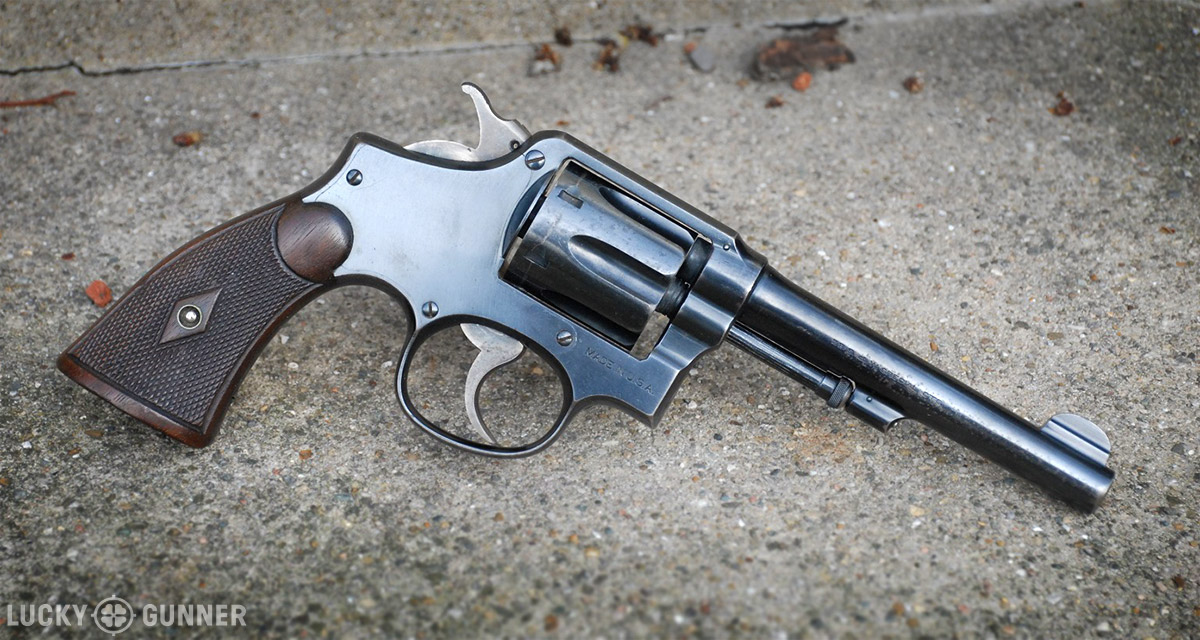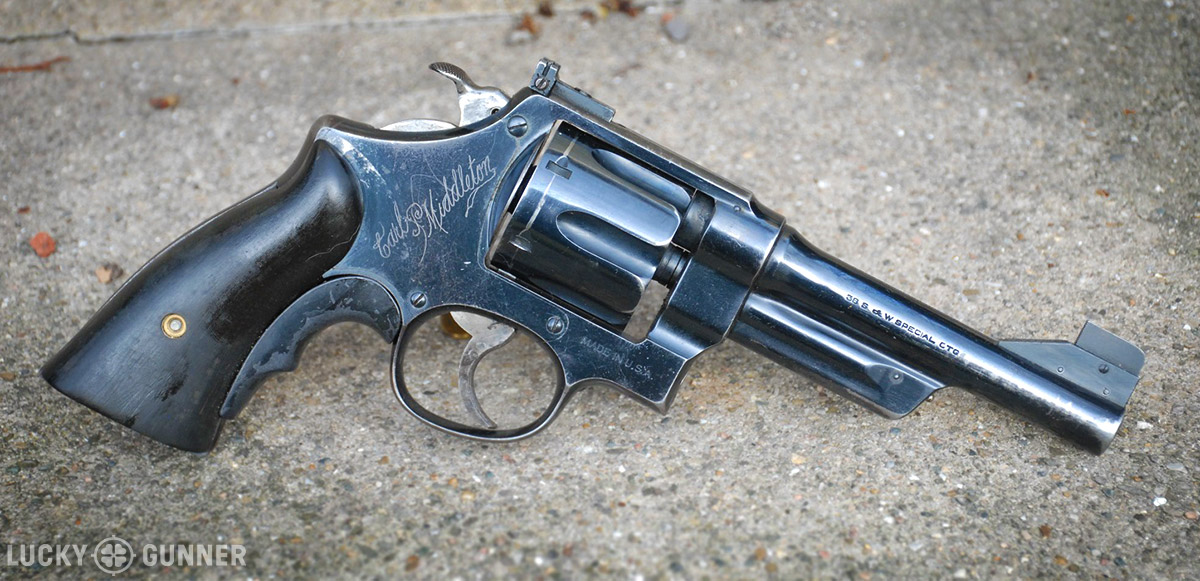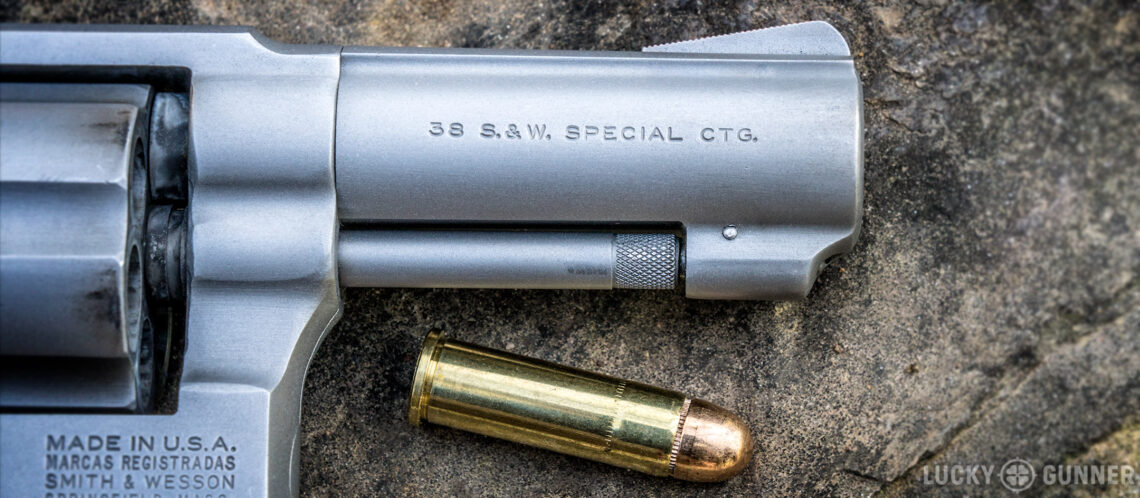Most stories begin at the beginning. To tell the story of the .38 Smith & Wesson Special cartridge, however, it’s necessary to go quite a ways back, before the beginning, back before metallic cartridge firearms entirely.
Certain bore diameters that are still with us today became standard back in the day when muzzleloading smoothbores were still measured in “gauge” or “bore”. Those numbers signified the number of round lead balls of that bore diameter it took to make a pound. The .72” caliber “12-bore” was, of course, popular among 18th Century frontstuffers and is still with us as a shotgun gauge. However, 50-, 60-, 100-, and 150-bore live on as well, as those work out to the bore diameters we all know today.
It’s the 100-bore size that became popular in Colt’s first revolving percussion pistol, the .36 caliber Paterson revolver. When the Republic of Texas Navy ordered 180 .36 Patersons, it represented Sam Colt’s first big martial sale. The bore size continued to be used in the Colt 1851 “Navy” revolvers that were common in the post-Civil War West and, eventually, was formalized in the first double-action revolver with a solid frame and swing-out cylinder to be general issue in the U.S. military, the Colt M1892.
The cartridge chambered in this revolver was known as the .38 Long Colt, and its big combat debut in the Spanish-American War was less than stellar. Smith & Wesson, who was working on a new revolver that would have been chambered for the service cartridge, immediately changed their plans.
The .38 Special is Born
The new medium-frame (known as the “K-frame” in Smith speak) revolver from S&W aped the swing-out cylinder and manual ejection of the Colt, causing it to be referred to as the “Hand Ejector” as opposed to the older top-break Smiths which automatically ejected the spent shells when broken open.
“The advertising literature of the day boasted that it launched a bullet hard enough to smash through eight and a half 7/8ths-inch pine boards, 125% as much as the competitor from Colt.”
Instead of chambering the new revolver in the .38 Long Colt, S&W developed a new cartridge of the same diameter but with the bullet weight upped from 150 to 158 grains and the powder charge likewise increased from 18 to 21½ grains of black powder. The resulting round, dubbed the .38 Smith & Wesson Special, boasted a serious performance increase. The advertising literature of the day boasted that it launched a bullet hard enough to smash through eight and a half 7/8ths-inch pine boards, 125% as much as the competitor from Colt. The cartridge was swiftly converted over to the new smokeless powder, albeit retaining the 158-grain lead round-nosed (LRN) projectile.

Perhaps in anticipation of future sales success, Smith dubbed the new K-frame Hand Ejector the “Military & Police”. Although nobody knew it when the first M&Ps hit store shelves in the closing year of the 19th Century, the most prolific service and defense handgun/cartridge combination of the next century had arrived. For most of the next eight decades, the medium-frame .38 Special Smith would be the iconic Good Guy gun.
The .38 Special in the 1900-1960s
Things got off to a slow start, however. The military fiddled with some ginormous Colt revolvers before adopting the M1911 pistol. The first several years of sales of the .38 M&P Smith consisted of about 20,000 .38 Special, including orders of a thousand guns apiece to the Army and Navy. Sales soon picked up, and the .38 Special 158-grain LRN eventually became a benchmark revolver cartridge for many years.
The first big variation on the .38 Special formula came almost three decades after the cartridge’s introduction. The Great Depression and Prohibition had given rise to the era of the motor bandit, and American gunmakers were pressured to deliver handguns that could defeat the heavy-gauge auto bodies and primitive bulletproof vests of the day. Colt souped up their .38 ACP into the .38 Super while Smith & Wesson decided to turbocharge their popular .38 Special.
The result was the .38/44 Heavy Duty, the numerical designator indicating that it was only intended to be fired in large-frame revolvers originally intended for the .44 Special round. It offered a claimed muzzle velocity of over 1100 feet per second. Since the cases were the same size as the regular .38 Special, it would be possible to fire them in a K-frame M&P, although that would not be advised. At best, it would lead to premature wear, and at worst, damage to the gun and shooter. It eventually led to the development of the .357 Magnum.

Around the same time period, heavy bullets were tried to increase the performance of the standard .38 Special against auto bodies. These 200-grain flat-point loadings were referred to by various manufacturers as “.38 Super Police” or “.38 Highway Patrol” loads. They stayed on the market for a while but never supplanted the basic 158-grain LRN.
The next big variation to the .38 Special happened in the 1950s. During WWII, the British military changed their issue revolver round from the original plain lead round nose to a metal-jacketed bullet for fear that the soft lead projectile might run afoul of the 1899 Hague Declaration prohibiting expanding bullets. Despite dabbling with some steel-jacketed ball, the standard US military .38 Special load remained the 158-grain LRN all through the war. After the war, the fledgling USAF, who issued .38 Special revolvers to aircrew and Security Police alike, decided to hedge their bets and shopped for a jacketed .38 issue round. The result was the 130-grain FMJ, which runs about fifty feet per second faster than the old 158-grain LRN. This is still a common load for sale at indoor ranges for air quality reasons and tends to print a little low out of fixed sight guns.
Things pretty much sailed along through the 50s and into the 60s, but big changes would come to self-defense ammo in the wake of the turbulent 60s and 70s.
The .38 Special 1970s-80s
In the early 70s, a new .38 Special loading made big waves as several police departments adopted it. The 158-grain lead semi-wadcutter hollow point (LSWCHP) loaded to +P pressures was probably first popularized by the St. Louis Police Department. Several other big cities followed: Albuquerque, Chicago, Dallas, Miami, to name a few. Then the Federal Bureau of Investigation hopped aboard, pretty much sealing the round’s reputation as “The FBI Load”.
“Expanding bullets were decried as ‘inhumane’ or ‘deadly’. In reaction to all the national talk about hollowpoints, public safety commissioner Reginald Eaves in my hometown of Atlanta had the APD issue low-velocity wadcutters, derided by the cops and some newspaper columnists as ‘Reggie Pellets’.”
Packing close to 200 feet per second more steam than the traditional 158-grain LRN and featuring an expanding hollowpoint bullet to boot, the 158gr +P LSWCHP developed a reputation for being a much more effective fight-stopper than the old lead round nose. Furthermore, the acceptance of this loading by big city PDs and the FBI helped speed the process of legitimizing expanding bullets for law enforcement and, by extension, for armed citizen use.

For those not around at the time, this was a very big deal. The media, never very savvy to firearms technical issues, was in full hue and cry against the “Dum-Dum” bullets, as they called them, misidentifying them with obsolete British rifle ammo produced at the Indian arsenal of the same name. Expanding bullets were decried as “inhumane” or “deadly”. In reaction to all the national talk about hollowpoints, public safety commissioner Reginald Eaves in my hometown of Atlanta had the APD issue low-velocity wadcutters, derided by the cops and some newspaper columnists as “Reggie Pellets”. Fortunately, they were soon withdrawn.
Other alternatives to the 158-grain LRN began popping up on the landscape in the search for improved terminal performance. A light 110-grain JHP loaded beyond the SAAMI +P threshold was popularized by the Treasury department and its umbrella agencies such as the BATF. This was the 110-grain +P+ “Treasury load” or “Q load”. The light bullet and high-pressure charge made for a fast loading that put wear and tear on guns in a hurry, with almost magnum levels of muzzle blast. Lore behind the 110-grain +P+ JHP is that the agency wanted .357 Magnum performance without the political stigma (at the time) of issuing .357 Magnum revolvers. Remember, the general public was still getting used to the idea of hollow points! The Treasury load was also used by the Border Patrol and California Highway Patrol.
As the 70s rolled into the 80s, the .38 Special continued to evolve as a defensive cartridge, but its days of dominance were also drawing to a close. Many departments had adopted the .357 Magnum, bad PR be damned. More importantly, the perception that the police were “outgunned” by the bad guys would lead to even bigger shifts in the .38 market.
But that’s for Part Two…
Be sure to check out our ballistic gelatin test to find out how some of these old favorite .38 Special loads perform compared to modern hollow point bullets.

I love my SP101 .357 revolver, but I only load it with .38spl +P hollowpoints. The weight of the gun controls the extra pop of the +P load.
my “default-go-to-gun” is a 5-shot snub in .38 Special. I have other choices…but. Presently, I’m carrying a Ruger LCR-357 with .38 Special +P’s.
I do exactly what you do: Load my .357 LCR with .38 +P.
I’ve been casting and reloading .38 Special ammunition since 1970 and it’s still my favorite round. Maybe not the “hand loader’s dream” like the 10mm Auto, but it comes pretty close. In a decent sized revolver by my standard, I’ve never met a new shooter who didn’t like it; there have been many in my world and that’s saying a lot.
Standard pressure wadcutters are what I learned on, and what I teach newbies with. Even snubbies are fairly tame with that load.
A great read. Looking forward to part 2.
38 special-great cartridge, terrible band.
It is a S&W Model 64 with a 3″ barrel.
Thanks, that I what I assumed but I wasn’t sure. I would like to find one with a 3″ someday.
I have recently come back to the 38spl. A great, effective and versatile round! And I really enjoyed the history! I’d like to see more!
A lot of people have. Probably because the snubnosed revolvers have also made a big comeback with cwp holders.
So which .38 round wasn’t effective in the Philippines against the Moro tribesman that brought in the .45ACP?
,38 Long Colt
I thought it was the .38 Smith & Wesson, the round the WWII Model 10 Victory used, that gave such poor performance against the Moros.
No, it was definitely the .38 Long Colt. Remember that all of the US military service branches issued Colt DA revolvers starting in the late 19th Century. S&W based its .38 Special upon a lengthened .38 Long Colt case in order to guarantee backwards compatibility with the standard US military issue cartridge of the era. If the US military had been using the .38 S&W, the .38 Special would have almost certainly been a lengthened .38 S&W.
It was the British Army that based their .380/200 service load on the smaller .38 S&W. At the time, they had a weird wound ballistic theory that its limited penetration would somehow give superior results. As the WW2-era Victory Models were intended for British issue, they were chambered for their standard revolver cartridge. S&W was scrambling to make up with the British MoD for the botched 9mm Light Rifle contract.
…And those Moros were only about 110 LBS.
A couple of misfires in the article:
The .38 S&W Super Police was a version of the British .38-200 marketed Stateside, not a version of the .38 S&W Special. The Brits dropped the all-lead 200 grain bullet in the mid-late ’30s, not the ’50s, and the Brit caliber was the older, shorter, slightly larger diameter (.360″), and less powerful (’bout on par with .380 ACP) .38 S&W.
There was a .38 Special variant of the “Super Police” load as well as the .38 S&W. US ammunition manufacturers cataloged the 200gr .38 Special far longer than one might expect https://uploads.disquscdn.com/images/c731e4ef17466039e6a303e3c54a6ad559f77d64ca7d42dac2f8300685c0c5f2.jpg .
That said, the Highway Patrol and Hi-Way Master .38 Special loads typically used lightwieght (110gr) projectiles. The idea was that the higher velocity would aid in piercing the sheet metal of automobiles.
The “38” is really a “36” (.357)
Some of the early .38 caliber metallic cartridges used heel-seated, externally-lubricated projectiles that were much closer to 0.375-0.380″ at their widest diameter outside of the case. When manufacturers transitioned to inside-lubricated projectiles in extended variants of the original cartridge cases, the external diameters of the projectiles shrunk to what we see today.
Interesting, however I believe the bullet itself has always been a .36 caliber. One of the “problems” with cartridge nomenclature is that there is no actual standard convention. Anywho, thanks for the additional information.
The inside-lubricated projectiles were basically the same diameter as the heel of the outside-lubricated projectiles. However, that doesn’t change the fact that the exterior of the outside-lubricated projectile was roughly the same diameter as the exterior diameter of the cartridge case. Some custom shops still offer casting molds, projectiles, and loaded ammunition based upon the outside-lubricated designs.
Tam, why did you skip the .38 S&W predecessor to the .38 Special in your historical run-up?
Thanks for an interesting article!
A while back, I was shopping for .38 Special and, by mistake, bought a hundred rounds of .38 Super. The stuff worked, but it’s a tad bit wider than Special so the casings didn’t eject from my revolver very easily. No tragedies ensued, but it’s always interesting to read “the rest of the story.”
Nice article, Tams.
One nitpick… S&W chambered several thousand Model 1899 M&Ps in .38 Long Colt, including runs for the US Army and US Navy, and at least several hundred that were sold commercially.
My desk gun is a Smith J-frame with +p HPs. It drops into a pocket too, for outdoor concealed carry if desired. I have a couple other .38 specials I sometimes carry, a Police Positive Special and a pre-war pre-model 10, M&P. Both made in the 1930’s, those are more “just cuz” collector pieces nowadays.
My open carry varies- Glock 21.45 or a Smith .40S&W. Unless Im in the mountains in which case the choice de joir is usually an M28 Smith .357 or a .44 mag….
I’m a revolver nut. That’s all I have. My CCW is a Smith 637. Love it!
OK your the right guy I need to talk to as a exclusive owner of revolvers.
I am just getting back into owning guns. I have a passion for revolvers as you do. I thinking of a S&W 686 3inch for a CCW. What would be your feelings on using this gun for a CCW?
Hello all. So, I just bough the Bodyguard. I was wondering if anyone had any ammo recommendations for home/carry protection. I know I will probably try a few before I settle but a guide would be helpful. Thanks in advance.
Still perfectly viable over 100 years down the road
My model 15 combat masterpiece from 1960’s is my nightstand gun. I bought my mom the plain yet robust Phillipino copy of the Colt, the Armscor m200.